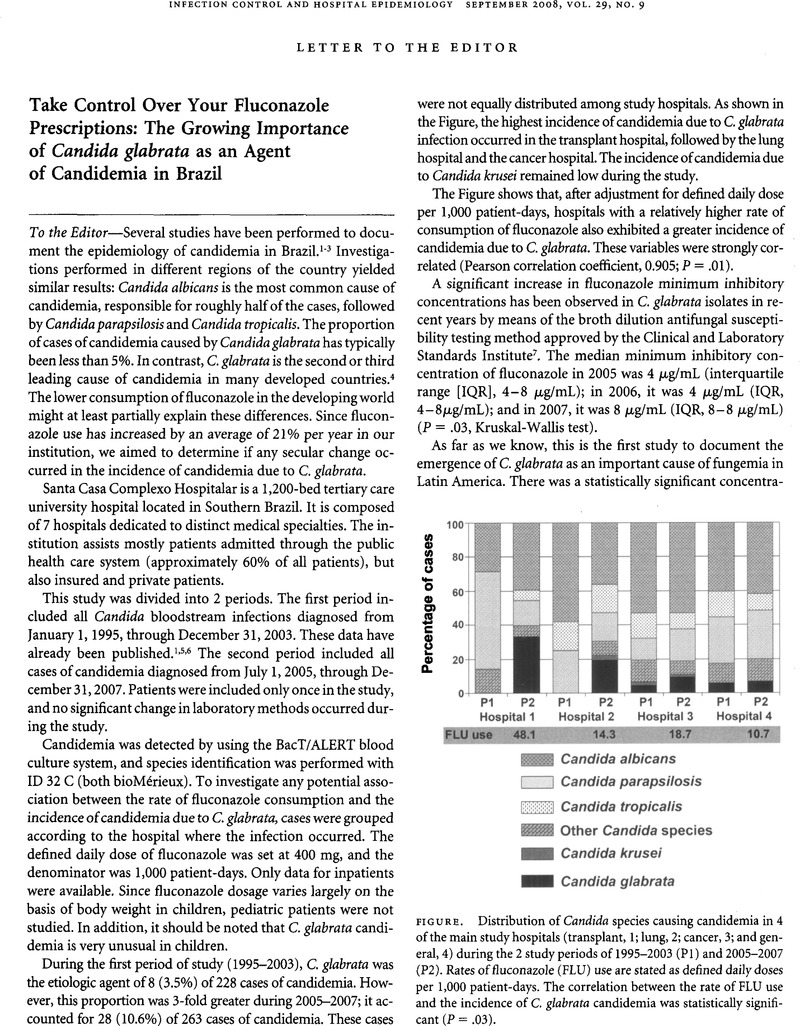Crossref Citations
This article has been cited by the following publications. This list is generated based on data provided by Crossref.
Pfaller, M. A.
Messer, S. A.
Hollis, R. J.
Boyken, L.
Tendolkar, S.
Kroeger, J.
and
Diekema, D. J.
2009.
Variation in Susceptibility of Bloodstream Isolates ofCandida glabratato Fluconazole According to Patient Age and Geographic Location in the United States in 2001 to 2007.
Journal of Clinical Microbiology,
Vol. 47,
Issue. 10,
p.
3185.
Pfaller, Michael A.
and
Diekema, Daniel J.
2010.
Epidemiology of Invasive Mycoses in North America.
Critical Reviews in Microbiology,
Vol. 36,
Issue. 1,
p.
1.
Sampaio Camargo, Thiago Zinsly
Marra, Alexandre Rodrigues
Silva, Claudia Vallone
Cardoso, Maria Fatima Santos
Martino, Marinês Dalla Valle
Camargo, Luis Fernando Aranha
and
Correa, Luci
2010.
Secular trends of candidemia in a tertiary care hospital.
American Journal of Infection Control,
Vol. 38,
Issue. 7,
p.
546.
Motta, Adriana Lopes
de Almeida, Gisele Madeira Duboc
de Almeida Júnior, João Nóbrega
Burattini, Marcelo Nascimento
and
Rossi, Flávia
2010.
Candidemia epidemiology and susceptibility profile in the largest Brazilian teaching hospital complex.
The Brazilian Journal of Infectious Diseases,
Vol. 14,
Issue. 5,
p.
441.
Pfaller, Michael A.
Diekema, Daniel J.
Gibbs, David L.
Newell, Vance A.
Barton, Richard
Bijie, Hu
Bille, Jacques
Chang, Shan-Chwen
da Luz Martins, Maria
Duse, Adriano
Dzierzanowska, Danuta
Ellis, David
Finquelievich, Jorge
Gould, Ian
Gur, Deniz
Hoosen, Anwar
Lee, Kyungwon
Mallatova, Nada
Mallie, Michele
Peng, NG Kee
Petrikos, George
Santiago, Axel
Trupl, Jan
VanDen Abeele, Ann Marie
Wadula, Jeannette
and
Zaidi, Mussaret
2010.
Geographic variation in the frequency of isolation and fluconazole and voriconazole susceptibilities of Candida glabrata: an assessment from the ARTEMIS DISK Global Antifungal Surveillance Program.
Diagnostic Microbiology and Infectious Disease,
Vol. 67,
Issue. 2,
p.
162.
Arendrup, Maiken Cavling
Bruun, Brita
Christensen, Jens Jørgen
Fuursted, Kurt
Johansen, Helle Krogh
Kjældgaard, Poul
Knudsen, Jenny Dahl
Kristensen, Lise
Møller, Jens
Nielsen, Lene
Rosenvinge, Flemming Schønning
Røder, Bent
Schønheyder, Henrik Carl
Thomsen, Marianne K.
and
Truberg, Kjeld
2011.
National Surveillance of Fungemia in Denmark (2004 to 2009).
Journal of Clinical Microbiology,
Vol. 49,
Issue. 1,
p.
325.
Azevedo, Ana Carolina
Bizerra, Fernando César
Matta, Daniel Arquimedes da
de Almeida, Leila Paula
Rosas, Robert
and
Colombo, Arnaldo Lopes
2011.
In Vitro Susceptibility of a Large Collection of Candida Strains Against Fluconazole and Voriconazole by Using the CLSI Disk Diffusion Assay.
Mycopathologia,
Vol. 171,
Issue. 6,
p.
411.
Lopes Colombo, Arnaldo
Guimarães, Thaís
Aranha Camargo, Luis Fernando
Richtmann, Rosana
Queiroz-Telles, Flavio de
Costa Salles, Mauro José
da Cunha, Clóvis Arns
Shikanai Yasuda, Maria Aparecida
Luiza Moretti, Maria
and
Nucci, Marcio
2012.
Brazilian guidelines for the management of candidiasis: a joint meeting report of three medical societies – Sociedade Brasileira de Infectologia, Sociedade Paulista de Infectologia, Sociedade Brasileira de Medicina Tropical.
The Brazilian Journal of Infectious Diseases,
Vol. 16,
Issue. ,
p.
S1.
Pfaller, Michael A.
Castanheira, Mariana
Lockhart, Shawn R.
and
Jones, Ronald N.
2012.
Candida glabrata: Multidrug Resistance and Increased Virulence in a Major Opportunistic Fungal Pathogen.
Current Fungal Infection Reports,
Vol. 6,
Issue. 3,
p.
154.
Nucci, Marcio
Thompson-Moya, Luis
Guzman-Blanco, Manuel
Tiraboschi, Iris Nora
Cortes, Jorge Alberto
Echevarría, Juan
Sifuentes, Jose
Zurita, Jeannete
Santolaya, María E.
Alvarado Matute, Tito
de Queiroz Telles, Flavio
and
Colombo, Arnaldo Lopes
2013.
Recommendations for the management of candidemia in adults in Latin America.
Revista Iberoamericana de Micología,
Vol. 30,
Issue. 3,
p.
179.
Schultz, Vanessa
Colombo, Arnaldo Lopes
and
Pasqualotto, Alessandro Comaru
2013.
Invasive candidosis: contrasting the perceptions of infectious disease physicians and intensive care physicians.
Revista da Sociedade Brasileira de Medicina Tropical,
Vol. 46,
Issue. 4,
p.
466.
Colombo, Arnaldo L.
Garnica, Marcia
Aranha Camargo, Luis Fernando
Da Cunha, Clovis Arns
Bandeira, Antonio Carlos
Borghi, Danielle
Campos, Tatiana
Senna, Ana Lucia
Valias Didier, Maria Eugenia
Dias, Viviane Carvalho
and
Nucci, Marcio
2013.
Candida glabrata: an emerging pathogen in Brazilian tertiary care hospitals.
Medical Mycology,
Vol. 51,
Issue. 1,
p.
38.
Wille, Marcos Paulo
Guimaraes, Thais
Furtado, Guilherme Henrique Campos
and
Colombo, Arnaldo Lopes
2013.
Historical trends in the epidemiology of candidaemia: analysis of an 11-year period in a tertiary care hospital in Brazil.
Memórias do Instituto Oswaldo Cruz,
Vol. 108,
Issue. 3,
p.
288.
Moretti, Maria Luiza
Trabasso, Plinio
Lyra, Luzia
Fagnani, Renata
Resende, Mariangela Ribeiro
de Oliveira Cardoso, Luis Gustavo
and
Schreiber, Angélica Zaninelli
2013.
Is the incidence of candidemia caused byCandida glabrataincreasing in Brazil? Five-year surveillance ofCandidabloodstream infection in a university reference hospital in southeast Brazil.
Medical Mycology,
Vol. 51,
Issue. 3,
p.
225.
Colombo, Arnaldo Lopes
Guimarães, Thaís
Camargo, Luis Fernando Aranha
Richtmann, Rosana
de Queiroz-Telles, Flavio
Salles, Mauro José Costa
da Cunha, Clóvis Arns
Yasuda, Maria Aparecida Shikanai
Moretti, Maria Luiza
and
Nucci, Marcio
2013.
Brazilian guidelines for the management of candidiasis – a joint meeting report of three medical societies: Sociedade Brasileira de Infectologia, Sociedade Paulista de Infectologia and Sociedade Brasileira de Medicina Tropical.
The Brazilian Journal of Infectious Diseases,
Vol. 17,
Issue. 3,
p.
283.
Nucci, Marcio
Thompson-Moya, Luis
Guzman-Blanco, Manuel
Tiraboschi, Iris Nora
Cortes, Jorge Alberto
Echevarría, Juan
Sifuentes, Jose
Zurita, Jeannete
Santolaya, María E.
Alvarado Matute, Tito
de Queiroz Telles, Flavio
and
Colombo, Arnaldo Lopes
2013.
Recomendaciones para el manejo de la candidemia en adultos en América Latina.
Revista Iberoamericana de Micología,
Vol. 30,
Issue. 3,
p.
179.
da Costa, Viviane Gevezier
Quesada, Regina Mariuza Borsato
Abe, Aline Tancler Stipp
Furlaneto-Maia, Luciana
and
Furlaneto, Márcia Cristina
2014.
Nosocomial Bloodstream Candida Infections in a Tertiary-Care Hospital in South Brazil: A 4-Year Survey.
Mycopathologia,
Vol. 178,
Issue. 3-4,
p.
243.
Lewis, Russell E.
and
Kontoyiannis, Dimitrios P.
2014.
Candida and Candidiasis.
p.
373.
Pfaller, Michael A.
and
Diekema, Daniel J.
2014.
Candidaand Candidiasis.
p.
449.
Colombo, Arnaldo L.
Guimarães, Thais
Sukienik, Teresa
Pasqualotto, Alessandro C.
Andreotti, Ricardo
Queiroz-Telles, Flavio
Nouér, Simone A.
and
Nucci, Marcio
2014.
Prognostic factors and historical trends in the epidemiology of candidemia in critically ill patients: an analysis of five multicenter studies sequentially conducted over a 9-year period.
Intensive Care Medicine,
Vol. 40,
Issue. 10,
p.
1489.



